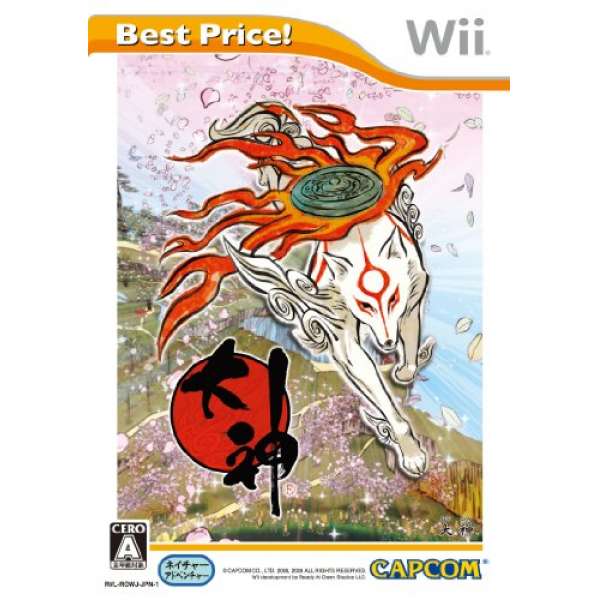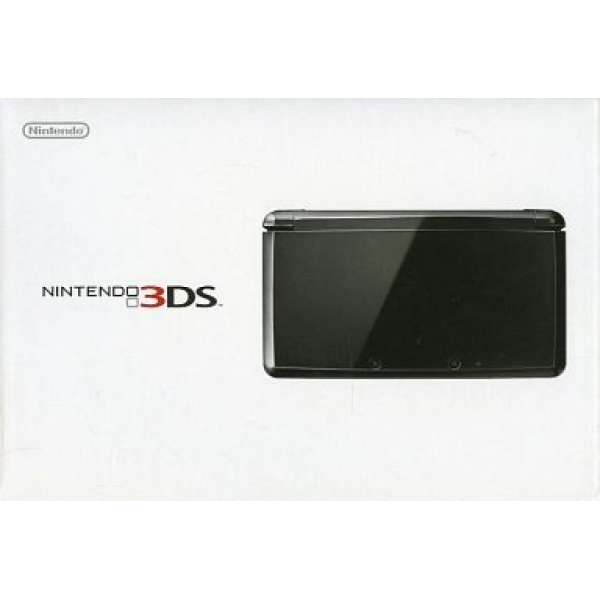大神 Best版
《大神》(Ōkami)是結合動作冒險與神話元素的經典遊戲,由日本Clover Studio開發,Capcom於2006年首次推出,Wii版本則於2008年由Ready at Dawn負責移植。最初登上PlayStation 2,但Wii版因其精準的體感控制與更加直覺的繪圖操作而受到廣泛關注,成為Wii平台上備受推崇的藝術性作品之一。
故事設定在受日本神話啟發的幻想世界,白狼的太陽女神「天照大神(Amaterasu)」,她受月之神「月讀」之邀,再次降臨凡間,以對抗甦醒的古老邪惡─八岐大蛇(Yami no Orochi)。千年前,天照大神曾經拯救世界,然而隨著人類對神明的信仰逐漸淡薄,邪氣再次蔓延。遊戲的開場從小村落「神木村」出發,天照大神在小精靈「一寸法師(Issun)」的陪伴下展開旅程,踏遍整個國度,淨化被詛咒的大地,幫助村民,最終面對混沌的源頭。
故事融合許多日本古代傳說角色與妖怪,如因幡的白兔、大國主命、以及天之岩戶等神話元素。雖然劇情設定神聖而宏大,但遊戲中的語言與角色對話卻不時穿插幽默與現代語感,讓整體氛圍在神話與人性之間取得巧妙平衡。
Wii版本《大神》的一大特色,就是對Wii遙控器的靈活應用。操作天照大神進行戰鬥、奔跑、跳躍與解謎之外,最關鍵的就是「筆神之力」——透過「神筆模式」,按下按鈕進入暫停畫面,然後使用遙控器像畫筆般在畫面上「繪圖」來觸發各種神力。例如畫出一條直線可斬斷障礙物、畫一圈太陽可讓晝夜更替、畫水流可改變河道等。
這套系統在Wii上的體驗比PS2更直觀,因為可以直接以手勢在空中揮筆,模擬揮灑墨水的動作,更貼近真實「畫筆」的使用感。這種創新的互動設計,不僅用於戰鬥,也貫穿整個探索與解謎過程,形成獨特的遊戲節奏與沉浸感。
視覺風格極具藝術性,採用水墨畫風格呈現整個遊戲世界,角色、背景、甚至敵人設計都像是從古代屏風或浮世繪中走出來的一般。這種「浮世繪×3D」的混合技術不僅讓遊戲畫面在當時顯得獨樹一幟,也為它贏得許多設計與藝術相關的獎項。
音樂方面則大量採用和風器樂,如尺八、古箏與太鼓等,搭配劇情起伏,從輕快村莊音樂到史詩級Boss戰配樂皆充滿東方色彩。遊戲幾乎沒有真正的語音,角色對話以模糊的擬音表現,讓人能將注意力放在畫面與氣氛上,增添一種童話般的敘事魅力。
在Wii上的表現雖非商業巨作,但在評論界幾乎一致獲得極高評價。IGN給予Wii版9.0分,讚揚其創新玩法與美術風格,並指出筆刷操作在Wii平台上的表現比原作更流暢、直覺。GameSpot則給出9.3分,強調這是「應該被每個藝術愛好者與動作冒險玩家體驗一次的作品」。
不過也有評論指出,在影像解析度與字體顯示上略顯模糊,加上部分筆刷判定不夠靈敏,會讓某些解謎操作重複嘗試。但即便如此,大多數玩家仍認為這些小缺點無損遊戲的整體美感與體驗。更重要的是,《大神》成為少數能結合藝術性與互動樂趣的作品,並被後世稱為「遊戲界的浮世繪」。雖然銷量不如主流動作遊戲,但在藝術學界、設計專題與文化討論中長期被引用,是少數能同時打動遊戲玩家與非玩家群體的代表性遊戲。
總結來說,這是將傳統東方文化、藝術視覺與創新互動完美融合的作品。既是一場關於神話與救贖的冒險,也是一段關於信仰、美與創造的電子藝術旅程。對於尋求不同於商業主流、想感受遊戲作為藝術載體可能性的玩家而言,無疑是值得珍藏的經典體驗。
Ōkami is a classic game that blends action-adventure gameplay with elements of mythology. Originally developed by Japan's Clover Studio and published by Capcom in 2006, the Wii version, released in 2008, was ported by Ready at Dawn. While it first appeared on the PlayStation 2, the Wii version gained wide attention for its precise motion controls and more intuitive drawing mechanics, becoming one of the most acclaimed artistic titles on the Wii platform.
The story is set in a fantasy world inspired by Japanese mythology. The sun goddess, Amaterasu, reincarnates in the form of a white wolf at the invitation of Tsukuyomi, the god of the moon, to confront the ancient evil Orochi, who has reawakened. A thousand years prior, Amaterasu had once saved the world, but as human faith in the gods waned, darkness began to spread once again. The journey begins in the small village of Kamiki, with Amaterasu accompanied by the tiny wandering artist Issun, traveling across the land to purify cursed areas, help villagers, and ultimately confront the source of chaos.
The narrative incorporates numerous figures and elements from traditional Japanese legends and folklore, including the White Hare of Inaba, Ōkuninushi, and the story of the Amano-Iwato (Heavenly Rock Cave). Though the overarching plot carries a sacred, epic tone, the dialogue and interactions often feature humor and a modern sensibility, striking a delicate balance between mythological grandeur and human relatability.
A major highlight of the Wii version is its dynamic use of the Wii Remote. Beyond basic actions like fighting, running, jumping, and puzzle-solving, the key mechanic is the Celestial Brush—through "brush mode," players pause the game and use the Wii Remote like a paintbrush, drawing on the screen to unleash divine powers. Drawing a straight line can cut through obstacles, painting a circle can summon the sun, and sketching a flowing stream can alter rivers, among many other effects.
This system feels even more intuitive on Wii than it did on PS2, as players can physically mimic the action of painting in the air, enhancing the immersive feel of wielding a real brush. This innovative mechanic is not limited to battles; it runs throughout exploration and puzzle-solving, creating a unique rhythm and deeply immersive experience.
Visually, Ōkami stands out with its artistic style, presenting the entire world in a sumi-e (ink wash painting) aesthetic. Characters, environments, and enemies all look as if they've stepped out of ancient folding screens or ukiyo-e prints. This hybrid of "ukiyo-e × 3D" technology not only made the game visually distinct at its time of release but also earned it numerous awards for art and design.
The soundtrack heavily features traditional Japanese instruments, such as shakuhachi (bamboo flute), koto (zither), and taiko drums, perfectly syncing with the story's emotional highs and lows. From lighthearted village tunes to grandiose boss battle themes, the music infuses the game with a rich Eastern atmosphere. Dialogue is conveyed not through full voice acting, but via stylized gibberish sounds, allowing players to focus more on the visual storytelling and enhancing the game's fairytale-like tone.
Although Ōkami on Wii was not a major commercial hit, it received near-universal critical acclaim. IGN awarded the Wii version a 9.0, praising its innovative gameplay and visual style, and noted that the brush mechanics were even more fluid and intuitive on the Wii than in the original. GameSpot rated it 9.3, calling it "an experience that every lover of art and action-adventure should have."
Some criticisms pointed out slight blurriness in the image resolution and font display, and that the brush mechanics could sometimes be finicky, requiring multiple attempts to execute certain puzzles. Nevertheless, most players agreed that these minor flaws did not detract from the game's overall beauty and impact.
More importantly, Ōkami became one of the few titles able to successfully merge artistry and interactivity, later being described as "the ukiyo-e of the gaming world." Although its sales were modest compared to mainstream action titles, it has been cited for years in academic studies, design discussions, and cultural analyses, standing as a rare example of a video game that can touch both gamers and non-gamers alike.
In conclusion, Ōkami is a masterpiece that perfectly fuses traditional Eastern culture, artistic visuals, and innovative interactivity. It is both a grand mythological adventure and an artistic journey about faith, beauty, and creation. For players seeking an experience different from mainstream commercial games and wanting to explore the potential of video games as an artistic medium, Ōkami remains an unforgettable classic.
運費計算方式:
貨款滿1000元運費外加90元
貨款1000以下:買1件運費外加 60元,買2件運費外加 70元,
買3件運費外加 80元 ,買4件運費外加 90元
貨到付款外加30元手續費
外島及大陸地區運費另計
付款方式:
線上刷卡:本站採用Paypal線上刷卡
虛擬帳號匯款:屬於您專屬的虛擬帳戶,方便站長查帳使用,本站強力推薦
實體ATM匯款:請將匯款帳號記錄下來至各大銀行ATM提款機轉帳
超商條碼繳費:請列印本站提供的條碼至四大超商繳費
線上轉帳:透過玉山銀行線上ATM轉帳(此系統只支援IE瀏覽器)
貨到付款:本站採用黑貓宅急便貨到付款
其他注意事項:
如需購買線上點數卡請直接跟站長連絡,本站不提供點數卡的線上付款
-
大神 Best版
- 定 價: 2,200円
- 售 價: 199.00
- 庫存量: 1 套
- 已賣出: 0 套
 人氣指數: 0.5 / 6 顆星
人氣指數: 0.5 / 6 顆星 -
奧林匹亞的晚宴 Catharsis
- 定 價: 8,580円
- 售 價: 0.00
- 庫存量: 0 套
- 已賣出: 0 套
 人氣指數: 0.2 / 6 顆星
人氣指數: 0.2 / 6 顆星 -
風暴槍騎兵
- 定 價:
- 售 價: 0.00
- 庫存量: 0 套
- 已賣出: 0 套
人氣指數: 0.2 / 6 顆星 -
任天堂3DS主機 純黑色
- 定 價: 15,429円
- 售 價: 0.00
- 庫存量: 0 套
- 已賣出: 0 套
 人氣指數: 0.6 / 6 顆星
人氣指數: 0.6 / 6 顆星




